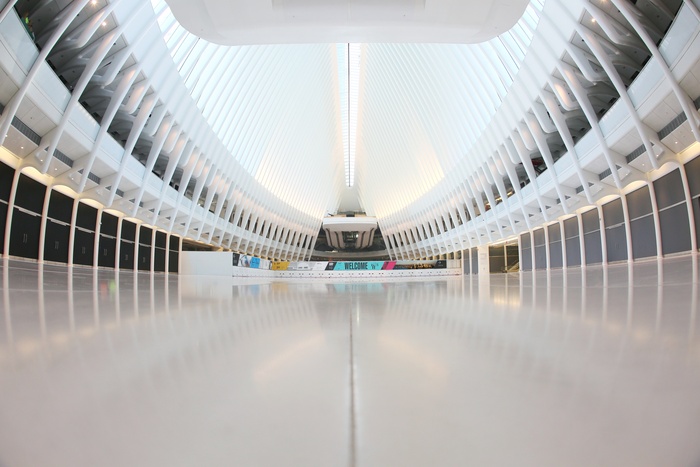By Paul Goldberger | Vanity Fair
Everyone knows that the World Trade Center Transportation Hub, designed by Santiago Calatrava, was insanely expensive—close to $4 billion at last count—and everyone knows that its design is just a little bit hokey, as if it were assembled out of dinosaur bones that were too big to fit into the Museum of Natural History. What most people don’t know is that if you can get yourself past all of that, and manage to push the dinosaur metaphors and the bird metaphors and all of that money out of your mind, you can have an architectural experience there that may renew your faith in the potential of the public realm in New York.
The Oculus, which is the name that has been given to the central space in Calatrava’s sprawling complex—the first sections of which open to the public on March 3 (the rest will open late this spring)—is the exhilarating nave of a genuine people’s cathedral. It is a room that soars; under a great arc of glass, Calatrava has put together curving ribs of steel to make a space that is uplifting, full of light and movement, and capable of inspiring something that has been in particularly short supply at Ground Zero, which is hope.
I’m not saying that to suggest that the Hub is a monument to the noblest ambitions of humankind. It is, after all, a train station bred to a shopping mall, and unlike Grand Central Terminal, where most of the shopping and restaurants are tucked into secondary spaces, at the World Trade Center the stores ring the monumental space. This place cost billions of dollars of public money, and it’s still a shrine to the commercial marketplace. I wish it were otherwise. But that doesn’t destroy the impact of the architecture, or negate the fact that this is the first time in a half a century that New York City has built a truly sumptuous interior space for the benefit of the public.
The last room connected to transportation that equaled this in ambition was Eero Saarinen’s great TWA Terminal at Kennedy Airport, of 1962, a masterwork that has long inspired Calatrava and has directly influenced the form of several of his projects, including this one. In another way, however, the Oculus reminds me of an entirely different place, the last majestic public interior in New York—the Grand Promenade at the New York State Theater (now the David H. Koch Theater) at Lincoln Center, by Philip Johnson, of 1964. You can’t catch a train from there, but in some ways it’s more like Calatrava’s building than the place to which it is more often compared, Grand Central, since Johnson’s room, like Calatrava’s, is a deeply earnest attempt at civic grandeur that can seem to dance on the edge of garishness. The Grand Promenade is now one of New York’s most revered interior spaces, however, proving once again that yesterday’s vulgarity can become today’s landmark.
For Johnson, the questionable excess came in the form of lots of glitter and glitz. For Calatrava, it is in the oceans of white Italian marble, not just covering the main space of the Oculus but also all of the long connecting corridors that lead to the train platforms, to the neighboring buildings in the World Trade Center complex, and even to the tunnel under West Street to the Brookfield Place complex. The grand space of the Oculus itself is but the tip of Calatrava’s white-marble iceberg, and while all of these long connecting passageways make for good urban design, like the similar ones that tie Grand Central to its neighbors, does there need to be quite so much bright, white marble?
But the real point is that in a city that has built few noble public works in the last half century—a city that in our time has rarely even aspired to grandeur in public space, let alone achieved it—this project stands as a reminder that we have not given up entirely. Yes, it was inordinately expensive, and all of that marble couldn’t have helped the bottom line, but most of the high cost was due to the extraordinary engineering challenges of weaving a train station for Path commuters from New Jersey under and around several active New York City subway lines and all of the other construction at Ground Zero, not to mention the fact that the client was one of the world’s most inordinately cumbersome bureaucracies, the Port Authority.
Back when the 9/11 memorial opened a few years ago, I recall Michael Bloomberg saying something to the effect that people only complain about cost and delays when a project is underway; that once it is done, if it is any good, they forget all of that and pay attention to the thing itself. The Transportation Hub and its Oculus will put the Bloomberg Doctrine to a test, but I suspect it will pass, and that a couple of years from now, we will be hearing not about what this thing cost or about how long it took to build, but about how much people like walking through it. I certainly hope so, since nothing would be worse than to have it provoke a backlash against spending money on infrastructure. At a time when this country spends far less on public works than it should, the Hub is a rare exception to the trend. Its best legacy would be to encourage us to take more chances, and to recognize that investing in the public realm isn’t throwing away money. It is investing in the future, a gift from our generation to the ones that follow.


